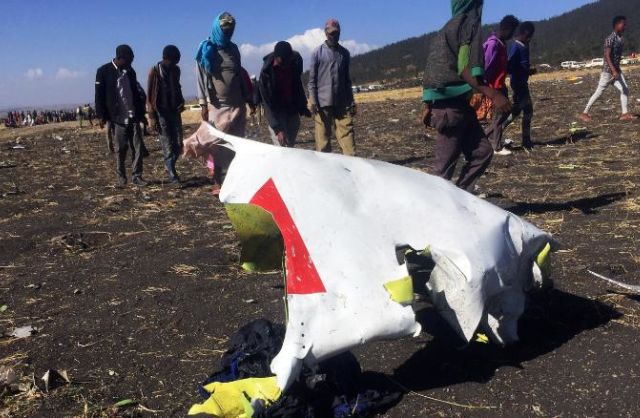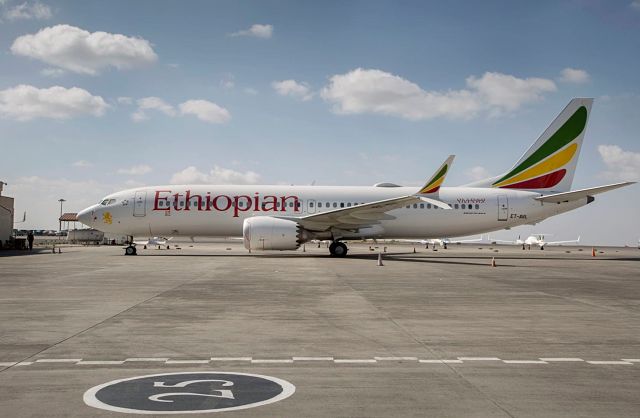 Boeing anti-stall system 'caused Ethiopia crash,' according to investigators looking into a B-737 MAX crash in Ethiopia that killed 157 on March 10th, the Wall Street Journal reported on Friday. (Photo: Airplane part at the scene of the Ethiopian Airlines Flight ET 302 plane crash, near the town of Bishoftu, southeast of Addis Ababa/Tiksa Negeri/Reuters)
Boeing anti-stall system 'caused Ethiopia crash,' according to investigators looking into a B-737 MAX crash in Ethiopia that killed 157 on March 10th, the Wall Street Journal reported on Friday. (Photo: Airplane part at the scene of the Ethiopian Airlines Flight ET 302 plane crash, near the town of Bishoftu, southeast of Addis Ababa/Tiksa Negeri/Reuters)
Reuters
Updated: MARCH 29, 2019
WASHINGTON – Investigators looking into a Boeing 737 MAX crash in Ethiopia that killed 157 people have reached a preliminary conclusion that an anti-stall system was activated before the plane hit the ground, the Wall Street Journal reported on Friday, citing people briefed on the matter.
U.S. safety investigators have reviewed data from the “black boxes” that were aboard Ethiopian Airlines Flight 302, four people briefed on the investigation told Reuters on Thursday. A preliminary report is expected as early as next week, the U.S. officials said.
The plane crashed on March 10 shortly after taking off from Addis Ababa.
Investigators of a deadly 737 MAX crash in Indonesia in October have also focused on the new anti-stall system, called MCAS. Boeing on Wednesday said a planned software fix would prevent repeated operation of the system that is at the centre of safety concerns.
Boeing’s fastest-selling 737 MAX jet, with orders worth more than $500 billion at list prices, has been grounded globally by the Federal Aviation Administration (FAA) and other regulators, although airlines are still allowed to fly them without passengers to move planes to other airports.
The manufacturer said it had developed a training package that 737 MAX pilots are required to take before the worldwide ban can be lifted, proposing as it did before two deadly crashes that those pilots do not need time on flight simulators to safely operate the aircraft.
On Thursday, a lawsuit against Boeing was filed in Chicago federal court by the family of Jackson Musoni, a citizen of Rwanda, who died in the Ethiopian Airlines crash.
The lawsuit alleges that Boeing had defectively designed the automated flight control system. Boeing said it could not comment on the lawsuit.
The amount and quality of training that Boeing and airlines provided to 737 MAX pilots is one of the issues under scrutiny as investigators around the world try to determine the causes of two 737 MAX crashes within five months.
The U.S. Department of Justice is investigating Boeing’s development process and what Boeing disclosed about MCAS.
The U.S. Transportation Department said on Monday that a new blue ribbon commission will review how the Federal Aviation Administration certifies new aircraft.
U.S. and European regulators knew at least two years before the Indonesian crash that the usual method for controlling the 737 MAX’s nose angle might not work in conditions similar to those in two recent disasters, Reuters reported on Friday, citing a document.
The European Aviation and Space Agency (EASA) certified the plane as safe in part because it said additional procedures and training would “clearly explain” to pilots the “unusual” situations in which they would need to manipulate a rarely used manual wheel to control, or “trim,” the plane’s angle.
Those situations, however, were not listed in the flight manual, according to a copy from American Airlines seen by Reuters. Boeing declined to comment on the EASA document.
NEW: Lawsuit Filed Against Boeing in U.S. Federal Court
—
Ethiopian official says plane crash report due this week

AP photo
By Elias Meseret | AP March 26
Ethiopian official says plane crash report due this week
ADDIS ABABA — A preliminary report on a March 10 Ethiopian Airlines crash that killed 157 people will be made public soon, but it may take months to finish the final report, a spokesman for the country’s transport ministry said.
“A date has not been set but it will be released later this week,” Mussie Yiheyis told The Associated Press Tuesday, adding that a high-ranking government official will announce the preliminary result.
“The U.S. National Transportation Safety Board, France’s BEA and an Ethiopian Transport Ministry department have been conducting the investigation,” he said. “It has been conducted as per International Civil Aviation Organization rules and regulations.”
On Monday, Ethiopian Airlines’ CEO Tewolde Gebremariam said the pilots who flew the plane that crashed on the outskirts of the capital, Addis Ababa, had trained on “all appropriate simulators,” rejecting reports that they had not been adequately prepared to handle the new aircraft.
There is speculation that the software could have contributed to the crash as well as to the crash of another Boeing 737 Max, a Lion Air flight in Indonesia in October.
Regulators say both planes had similar erratic flight paths shortly after take-off, an important part of their decision to ground the roughly 370 Max 8 planes around the world.
The preliminary report could come as early as Wednesday, the date that the U.S. Senate Commerce Committee’s aviation subcommittee has scheduled a public hearing on federal oversight of airline safety. Daniel Elwell, acting Federal Aviation Administration administrator; Calvin Scovel, the Transportation Department inspector general who is investigating approval of the Max; and Robert Sumwalt, chairman of the National Transportation Safety Board, are scheduled to testify, but not anyone from Boeing.
Senators’ questions likely will focus on how much the FAA knew about anti-stall software on the Max that was not disclosed to airlines and pilots until after the Lion Air crash, and why it approved the software. It’s the focus of investigations into both crashes because it automatically points down the nose of the plane to avoid an aerodynamic stall, and there’s evidence that pilots of both jets struggled to deal with it.
The New York Times reported Monday that pilots from five airlines tested current and updated software on a Boeing flight simulator. During a test that recreated conditions on the Lion Air flight, the pilots had less than 40 seconds to override the software before the plane uncontrollably plunged toward Earth, the newspaper said, citing two unidentified people involved in the testing.
Pilots can flip one switch to reverse a move by the software to point the nose down, and they can disable the software by flipping two switches at their knees.
Pilots involved in the simulator testing followed those steps and kept the plane under control using the current anti-stall software, the newspaper reported. The Lion Air pilots, on the other hand, had received little training on the system and it was only after the plane crashed that Boeing first notified pilots of the system’s existence.
Jason Goldberg, a pilot who has flown the Max 8 and is spokesman for the Allied Pilots Association, the union representing American Airlines pilots, said the anti-stall system “has significant control over the aircraft — it can pitch the nose down very significantly.”
He said it was “inexcusable for Boeing to omit this information from the pilot manuals for training. It’s a serious breach of trust.”
American Airlines has taken its 24 737 Max 8 planes out of the schedule at least through April 24.
On Saturday, Boeing confirmed that updated software will rely on data from more than one sensor before it automatically pushes the nose down. The system won’t repeatedly lower the nose as it seemed to do with Lion Air, and the software-controlled movement won’t be as abrupt. The update must be approved by the FAA and other countries’ regulators.
“We’re hopeful that Boeing will come up with a fix, but the process can’t be rushed,” Goldberg said.
He wouldn’t discuss Saturday’s simulator testing but said the union is pleased that Boeing and the FAA are taking input from pilots in testing the fix.
Ethiopian Airlines, widely seen as Africa’s best-managed airline, had been using five of the Max 8 planes and was awaiting delivery of 25 more. The airline has not made a decision on whether or not to cancel that order.
Boeing has invited more than 200 pilots, technical experts and regulators to its factory in Renton, Washington, for a briefing Wednesday on the software update.
Tom Krisher in Detroit and David Koenig in Dallas contributed to this report.
—
Related:
Boeing 737 Max Makes Emergency Landing in US
Vote of Confidence! Ethiopian Airlines Wins “African Champion of the Year” Award
Ethiopian Airlines Expresses Disappointment – Calls Out Media Outlets Eager to Blame Pilot
UPDATE: Preliminary info from flight 302 black box show ‘Clear similarities’ in Boeing crashes’ (AP)
Join the conversation on Twitter and Facebook.

























